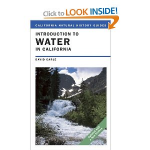
On page 220 of David Carle’s Introduction to Water in California is a map of California. The map was produced by the California Department of Water Resources in 1998.
On the map, California is divided into ten regions. For each region there are two sets of numbers, one blue, one red. The numbers represent projected water shortages for the year 2020. The blue numbers represent an average rainfall year, the red a drought year.
Only two regions are projected to have no shortages in an average year—the San Francisco Bay Area and the North Coast region. Every other region is projected to have water shortages even in years of average rainfall. The San Joaquin River region, blessed with the Merced, Tuolumne, Stanislaus and San Joaquin rivers, is nonetheless projected to have a shortfall of 63,000 acre-feet—this in a year of average rainfall.
Insiders have long known that even today the state of California can’t deliver all the water it has promised its ratepayers. In an average year, the State Water Project (SWP) delivers 2.3 million acre-feet of water. For that same year, the SWP has contracted to deliver 4.2 million acre-feet.
The difference between what the SWP can and cannot deliver is called “paper water.” Carle explains it this way:
“One of the surreal circumstances shaping California water policy is that the SWP cannot actually deliver the amounts in its contracts. This has created ‘paper water,’ as opposed to the essence of real life, ‘wet’ water. Paper water must not be used as the supply basis for authorizing new developments, nor marketed in water transfers.” (103)
“Water transfers” is the euphemism used for “water sales.” And even though the San Francisco Bay region is one of only two regions projected to have no shortages in an average rainfall year, the San Francisco Public Utilities Commission has been in ardent pursuit of more water for several years now.
Those who favor water sales are well aware of current and coming shortages. San Francisco in particular has always based its growth on the consumption of natural resources extracted from the surrounding countryside. Citing the San Francisco mantra that has always driven its appetite for resources, Carle quotes a San Francisco Chronicle editorial from 1989:
“‘Economic growth, of course, depends on population growth…Population growth depends absolutely on guaranteed—and continuing and growing—supplies of good quality drinking water.’”
Population growth has been and will remain the Golden Fleece pursued not just by the urban megalopolis but by cities and towns of all sizes throughout the state. But since we’re already out of water, there are only two sources to draw from—agriculture and the environment:
“Pressures for continued urban growth are the greatest threats to long-term agricultural production and meaningful environmental protection in California. Recent commitments of water to the environment are not new ‘demands’ on supply, but belated recognition that too much essential water was taken away in the past…The future increases in ‘demand’ predicted by water planners are based primarily on uncontrolled urban population growth.” (221)
Promoters of urban growth rely on an uninformed public and a “divide and conquer” strategy that pits agricultural and environmental interests against one another to further their goals of acquiring water rights.
Thus, those who would sell water will demonize those who would increase river flows for fish and the environment. When proponents of water for farmland speak out against water sales, they will be pitted against environmentalists rather than promoters of urban growth.
All the while, those who would pay seemingly stratospheric prices for California water know one thing those who would sell it do not: Water in California is priceless. Today’s exorbitant price is tomorrow’s losing bid.

Mr. Caine
Most respectfully, I find you haven’t a clue of what you wrote about. I hope you are not teaching what you wrote to your clueless college students.
Look – I worked at a giant water agency in California for 20 years. I did not get a water education only out of books and propaganda. In a DRY year in California, there is 145 million acre feet of rainfall. That is sufficient to support 725 million urban people or 48,333,333 acres of cropland. The problem is the water falls where people mainly do not live. What we need is more water capture, storage, and conveyance. The environment need not lose out in better water management since a significant amount of water flows to the ocean or flows to the sky.
Best regards,
Thank you Wayne. Those who are offering all that money for water will be happy to know there’s no problem after all.
You are as nuts as the engineers who ran the Albuquerque Wateer Utility in the 1970’s. Shortly after building the first digital computer model of the Tucson Basin in 1971 and after running a number of scenarios I reaized that Albuquerque would be in the same deep manure pile if something was not done in the Albuquerque Basin. This was at a time when our engineers were telling us that we lived on the shores of an underground Lake Superior which I knew to be unmitigated nonsense. When I approached the city engineers they gave me the same response you give: more wells, pumps, pipes and storage tanks. We now know the assumptions were wrong and Albuquerque has implemented far reaching strategies to correct decades of engineer ignorance.
Have a nice day.